Assessing Temporal Trade-Offs of Ecosystem Services by Production Possibility Frontiers
Abstract
1. Introduction
2. Materials and Methods
2.1. Study Area
2.2. Data Sources and Pre-Processing
2.3. Quantifying ES and Temporal Changes
2.4. Estimating PPF Curves
2.5. Calculating Trade-Off Intensity
3. Results
3.1. Quantity of ES and Temporal Changes
3.2. PPF Curves for Pairwise ES Trade-Offs
3.3. Changes in Trade-Off Intensity
4. Discussion
4.1. Approaches for Estimating PPF
4.2. Implications
5. Conclusions
Supplementary Materials
Author Contributions
Funding
Data Availability Statement
Acknowledgments
Conflicts of Interest
References
- Millennium Ecosystem Assessment. Ecosystems and Human Well-Being: Synthesis; Island Press: Washington, DC, USA, 2005. [Google Scholar]
- Costanza, R.; De Groot, R.; Braat, L.; Kubiszewski, I.; Fioramonti, L.; Sutton, P.; Farber, S.; Grasso, M. Twenty years of ecosystem services: How far have we come and how far do we still need to go? Ecosyst. Serv. 2017, 28, 1–16. [Google Scholar] [CrossRef]
- Torres, A.V.; Tiwari, C.; Atkinson, S.F. Progress in ecosystem services research: A guide for scholars and practitioners. Ecosyst. Serv. 2021, 49, 101267. [Google Scholar] [CrossRef]
- Aryal, K.; Maraseni, T.; Apan, A. How much do we know about trade-offs in ecosystem services? A systematic review of empirical research observations. Sci. Total. Environ. 2022, 806, 151229. [Google Scholar] [CrossRef]
- Cavender-Bares, J.; Polasky, S.; King, E.; Balvanera, P. A sustainability framework for assessing trade-offs in ecosystem services. Ecol. Soc. 2015, 20, 17. [Google Scholar] [CrossRef]
- Howe, C.; Suich, H.; Vira, B.; Mace, G.M. Creating win-wins from trade-offs? Ecosystem services for human well-being: A meta-analysis of ecosystem service trade-offs and synergies in the real world. Glob. Environ. Chang. 2014, 28, 263–275. [Google Scholar] [CrossRef]
- Cavender-Bares, J.; Balvanera, P.; King, E.; Polasky, S. Ecosystem service trade-offs across global contexts and scales. Ecol. Soc. 2015, 20, 22. [Google Scholar] [CrossRef]
- Vallet, A.; Locatelli, B.; Levrel, H.; Wunder, S.; Seppelt, R.; Scholes, R.J.; Oszwald, J. Relationships Between Ecosystem Services: Comparing Methods for Assessing Tradeoffs and Synergies. Ecol. Econ. 2018, 150, 96–106. [Google Scholar] [CrossRef]
- Bennett, E.M.; Peterson, G.D.; Gordon, L.J. Understanding relationships among multiple ecosystem services. Ecol. Lett. 2009, 12, 1394–1404. [Google Scholar] [CrossRef]
- Birkhofer, K.; Diehl, E.; Andersson, J.; Ekroos, J.; Früh-Müller, A.; Machnikowski, F.; Mader, V.L.; Nilsson, L.; Sasaki, K.; Rundlöf, M.; et al. Ecosystem services—Current challenges and opportunities for ecological research. Front. Ecol. Evol. 2015, 2, 413. [Google Scholar] [CrossRef]
- Seppelt, R.; Dormann, C.F.; Eppink, F.V.; Lautenbach, S.; Schmidt, S. A quantitative review of ecosystem service studies: Approaches, shortcomings and the road ahead. J. Appl. Ecol. 2011, 48, 630–636. [Google Scholar] [CrossRef]
- Cardinale, B.J.; Duffy, J.E.; Gonzalez, A.; Hooper, D.U.; Perrings, C.; Venail, P.; Narwani, A.; Mace, G.M.; Tilman, D.; Wardle, D.A.; et al. Biodiversity loss and its impact on humanity. Nature 2012, 486, 59–67. [Google Scholar] [CrossRef]
- Lu, N.; Liu, L.; Yu, D.; Fu, B. Navigating trade-offs in the social-ecological systems. Curr. Opin. Environ. Sustain. 2021, 48, 77–84. [Google Scholar] [CrossRef]
- Koch, E.W.; Barbier, E.B.; Silliman, B.R.; Reed, D.J.; Perillo, G.M.; Hacker, S.D.; Granek, E.F.; Primavera, J.H.; Muthiga, N.; Polasky, S.; et al. Non-linearity in ecosystem services: Temporal and spatial variability in coastal protection. Front. Ecol. Environ. 2009, 7, 29–37. [Google Scholar] [CrossRef]
- Liu, L.; Wang, Z.; Wang, Y.; Zhang, Y.; Shen, J.; Qin, D.; Li, S. Trade-off analyses of multiple mountain ecosystem services along elevation, vegetation cover and precipitation gradients: A case study in the Taihang Mountains. Ecol. Indic. 2019, 103, 94–104. [Google Scholar] [CrossRef]
- Jaligot, R.; Chenal, J.; Bosch, M. Assessing spatial temporal patterns of ecosystem services in Switzerland. Landsc. Ecol. 2019, 34, 1379–1394. [Google Scholar] [CrossRef]
- Zhou, Z.; Robinson, G.M.; Song, B. Experimental research on trade-offs in ecosystem services: The agro-ecosystem functional spectrum. Ecol. Indic. 2019, 106, 105536. [Google Scholar] [CrossRef]
- Capriolo, A.; Boschetto, R.; Mascolo, R.; Balbi, S.; Villa, F. Biophysical and economic assessment of four ecosystem services for natural capital accounting in Italy. Ecosyst. Serv. 2020, 46, 101207. [Google Scholar] [CrossRef]
- Roy, S.G.; Uchida, E.; de Souza, S.P.; Blachly, B.; Fox, E.; Gardner, K.; Gold, A.J.; Jansujwicz, J.; Klein, S.; McGreavy, B.; et al. A multiscale approach to balance trade-offs among dam infrastructure, river restoration, and cost. Proc. Natl. Acad. Sci. USA 2018, 115, 12069–12074. [Google Scholar] [CrossRef] [PubMed]
- O’Connell, C.S.; Carlson, K.M.; Cuadra, S.; Feeley, K.J.; Gerber, J.S.; West, P.C.; Polasky, S. Balancing tradeoffs: Reconciling multiple environmental goals when ecosystem services vary regionally. Environ. Res. Lett. 2018, 13, 064008. [Google Scholar] [CrossRef]
- Ager, A.A.; Houtman, R.M.; Day, M.A.; Ringo, C.; Palaiologou, P. Tradeoffs between US national forest harvest targets and fuel management to reduce wildfire transmission to the wildland urban interface. For. Ecol. Manag. 2019, 434, 99–109. [Google Scholar] [CrossRef]
- Varian, H.R. Intermediate Microeconomics: A Modern Approach, 8th ed.; W.W. Norton & Co: New York, NY, USA, 2010. [Google Scholar]
- Bekele, E.G.; Lant, C.L.; Soman, S.; Misgna, G. The evolution and empirical estimation of ecological-economic production possibilities frontiers. Ecol. Econ. 2013, 90, 1–9. [Google Scholar] [CrossRef]
- Ruijs, A.; Wossink, A.; Kortelainen, M.; Alkemade, R.; Schulp, C. Trade-off analysis of ecosystem services in Eastern Europe. Ecosyst. Serv. 2013, 4, 82–94. [Google Scholar] [CrossRef]
- Bagdon, B.A.; Huang, C.-H.; Dewhurst, S.; Meador, A.S. Climate Change Constrains the Efficiency Frontier When Managing Forests to Reduce Fire Severity and Maximize Carbon Storage. Ecol. Econ. 2017, 140, 201–214. [Google Scholar] [CrossRef]
- Pohjanmies, T.; Eyvindson, K.; Triviño, M.; Mönkkönen, M. More is more? Forest management allocation at different spatial scales to mitigate conflicts between ecosystem services. Landsc. Ecol. 2017, 32, 2337–2349. [Google Scholar] [CrossRef]
- Bryan, B.A.; Crossman, N.D.; Nolan, M.; Li, J.; Navarro, J.; Connor, J.D. Land use efficiency: Anticipating future demand for land-sector greenhouse gas emissions abatement and managing trade-offs with agriculture, water, and biodiversity. Glob. Chang. Biol. 2015, 21, 4098–4114. [Google Scholar] [CrossRef]
- Li, R.; Li, R.; Zheng, H.; Yang, Y.; Ouyang, Z. Quantifying Ecosystem Service Trade-Offs to Inform Spatial Identification of Forest Restoration. Forests 2020, 11, 563. [Google Scholar] [CrossRef]
- Yang, W.; Jin, Y.; Sun, T.; Yang, Z.; Cai, Y.; Yi, Y. Trade-offs among ecosystem services in coastal wetlands under the effects of reclamation activities. Ecol. Indic. 2018, 92, 354–366. [Google Scholar] [CrossRef]
- Liu, X.; Xu, Z.; Yu, R. Spatiotemporal variability of drought and the potential climatological driving factors in the Liao River basin. Hydrol. Process. 2012, 26, 1–14. [Google Scholar] [CrossRef]
- Zhong, Y.; Zhong, M.; Feng, W.; Zhang, Z.; Shen, Y.; Wu, D. Groundwater Depletion in the West Liaohe River Basin, China and Its Implications Revealed by GRACE and In Situ Measurements. Remote Sens. 2018, 10, 493. [Google Scholar] [CrossRef]
- Zhu, Y.-H.; Zhang, S.; Sun, B.; Xi, X.-K.; Liu, Y.; Shi, X.-H. Spatial variability of soil organic carbon in the West Liao River Basin. Isr. J. Ecol. Evol. 2018, 64, 25–34. [Google Scholar] [CrossRef]
- Zhao, H.; Wang, Z.; Li, X.; Chu, Z.; Zhao, C.; Zhao, F. Research on the evolution characteristics of future climate change in West Liao River Basin. Environ. Sci. Pollut. Res. 2022, 29, 509–517. [Google Scholar] [CrossRef] [PubMed]
- Gao, Z.; He, J.; Dong, K.; Li, X. Trends in reference evapotranspiration and their causative factors in the West Liao River basin, China. Agric. For. Meteorol. 2017, 232, 106–117. [Google Scholar] [CrossRef]
- ArcGIS Desktop, version 10.6; ESRI: Redlands, CA, USA, 2018.
- NASA: Digital Elevation Model. Available online: https://asterweb.jpl.nasa.gov/GDEM.asp (accessed on 27 January 2023).
- Zhang, X.; Liu, L.; Chen, X.; Gao, Y.; Xie, S.; Mi, J. GLC_FCS30: Global land-cover product with fine classification system at 30 m using time-series Landsat imagery. Earth Syst. Sci. Data 2021, 13, 2753–2776. [Google Scholar] [CrossRef]
- Yue, T.; Yin, S.; Xie, Y.; Yu, B.; Liu, B. Rainfall erosivity mapping over mainland China based on high density hourly rainfall records. Earth Syst. Sci. Data 2022, 14, 665–682. [Google Scholar] [CrossRef]
- Yang, Q. Soil Erodibility Dataset of Pan-Third Pole 20 Countries; National Tibetan Plateau Data Center: Beijing, China, 2021. [Google Scholar]
- Peng, S. 1-km Monthly Precipitation Dataset for China (1901–2020); National Tibetan Plateau Data Center: Beijing, China, 2020. [Google Scholar]
- Peng, S. (1 km Monthly Potential Evapotranspiration Dataset in China (1990–2020); National Tibetan Plateau Data Center: Beijing, China, 2022. [Google Scholar]
- Hengl, T.; De Jesus, J.M.; Heuvelink, G.B.M.; Gonzalez, M.R.; Kilibarda, M.; Blagotić, A.; Shangguan, W.; Wright, M.N.; Geng, X.; Bauer-Marschallinger, B.; et al. SoilGrids250m: Global gridded soil information based on machine learning. PLoS ONE 2017, 12, e0169748. [Google Scholar] [CrossRef] [PubMed]
- Poggio, L.; de Sousa, L.M.; Batjes, N.H.; Heuvelink, G.B.M.; Kempen, B.; Ribeiro, E.; Rossiter, D. SoilGrids 2.0: Producing soil information for the globe with quantified spatial uncertainty. Soil 2021, 7, 217–240. [Google Scholar] [CrossRef]
- National Catalogue Service for Geographic Information: Railroad. Available online: https://www.webmap.cn (accessed on 27 January 2023).
- National Catalogue Service For Geographic Information: Road. Available online: https://www.webmap.cn, (accessed on 27 January 2023).
- InVEST, version 3.12; Natural Capital Project: Stanford, CA, USA, 2022.
- Stanford University; University of Minnesota; Chinese Academy of Sciences; The Nature Conservancy; World Wildlife Fund; Stockholm Resilience Centre. User’s Guide; 2022. Available online: https://storage.googleapis.com/releases.naturalcapitalproject.org/invest-userguide/latest/index.html, (accessed on 12 May 2022).
- Matlab, version R2021b; MathWorks: Galway, Ireland, 2021.
- GeoGebra Classic; GeoGebra: Linz, Austria, 2022.
- Turkelboom, F.; Leone, M.; Jacobs, S.; Kelemen, E.; García-Llorente, M.; Baró, F.; Termansen, M.; Barton, D.N.; Berry, P.; Stange, E.; et al. When we cannot have it all: Ecosystem services trade-offs in the context of spatial planning. Ecosyst. Serv. 2018, 29, 566–578. [Google Scholar] [CrossRef]
- Goldstein, J.H.; Caldarone, G.; Duarte, T.K.; Ennaanay, D.; Hannahs, N.; Mendoza, G.; Polasky, S.; Wolny, S.; Daily, G.C. Integrating ecosystem-service tradeoffs into land-use decisions. Proc. Natl. Acad. Sci. USA 2012, 109, 7565–7570. [Google Scholar] [CrossRef]
- King, E.; Cavender-Bares, J.; Balvanera, P.; Mwampamba, T.H.; Polasky, S. Trade-offs in ecosystem services and varying stakeholder preferences: Evaluating conflicts, obstacles, and opportunities. Ecol. Soc. 2015, 20, 25. [Google Scholar] [CrossRef]
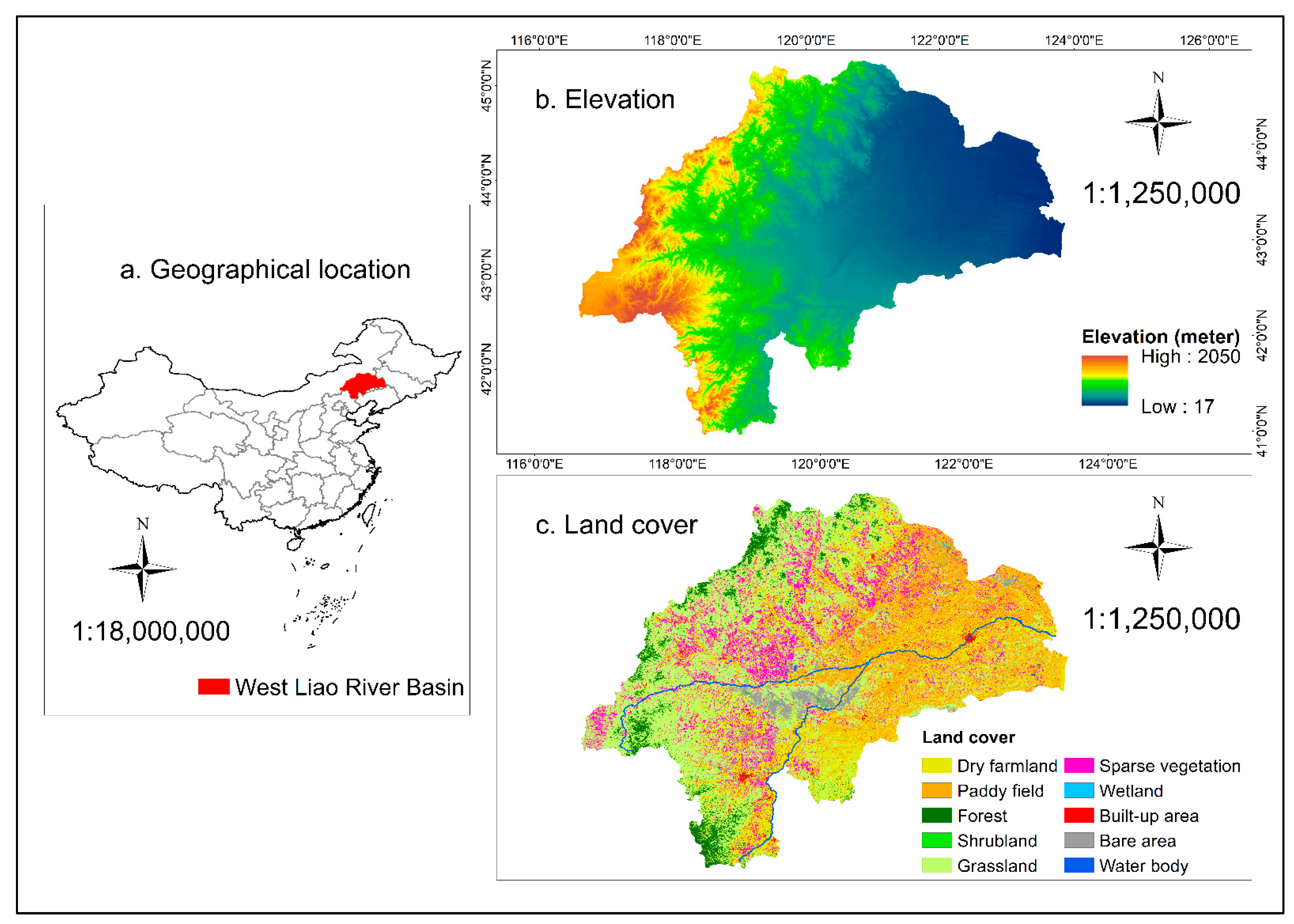
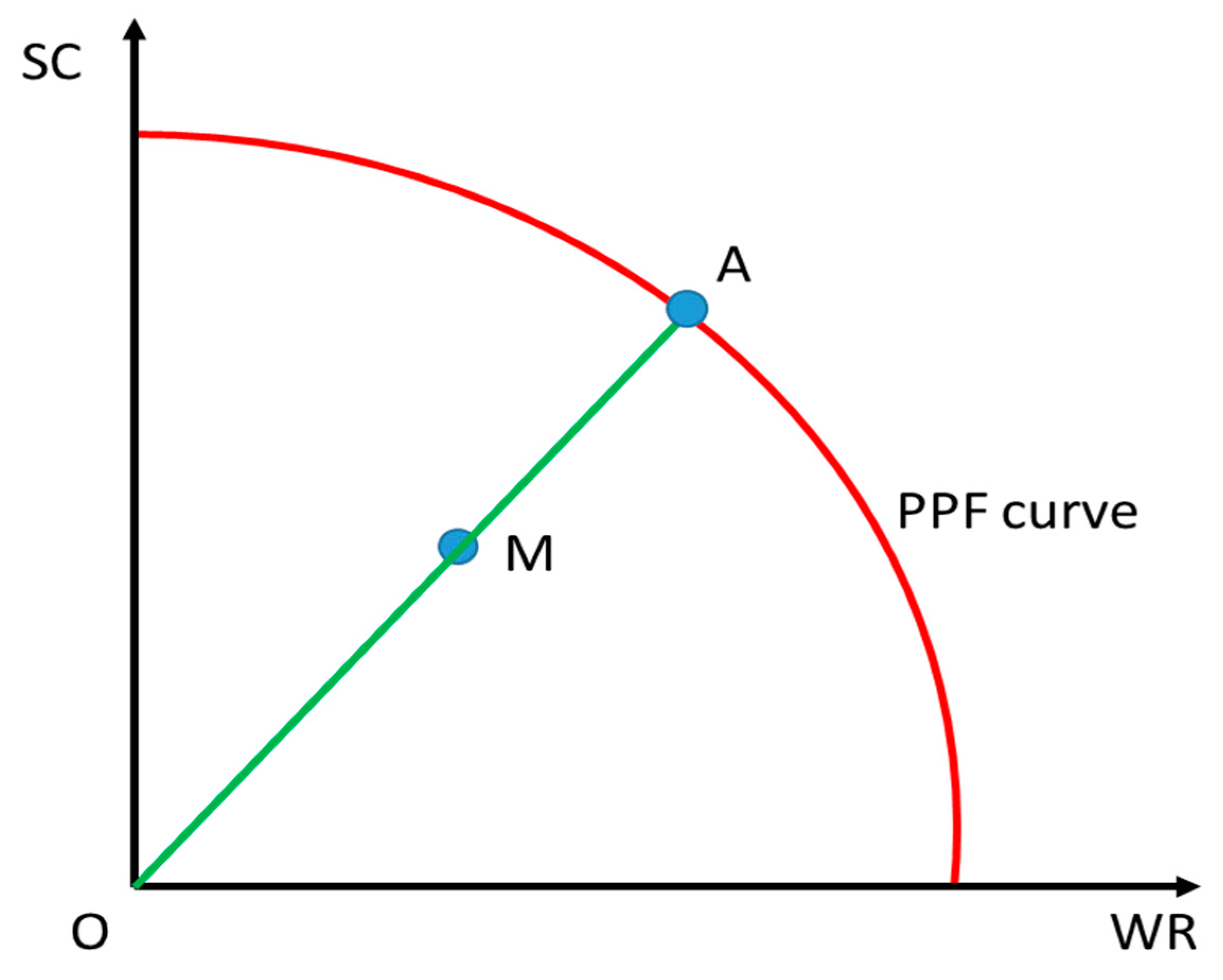

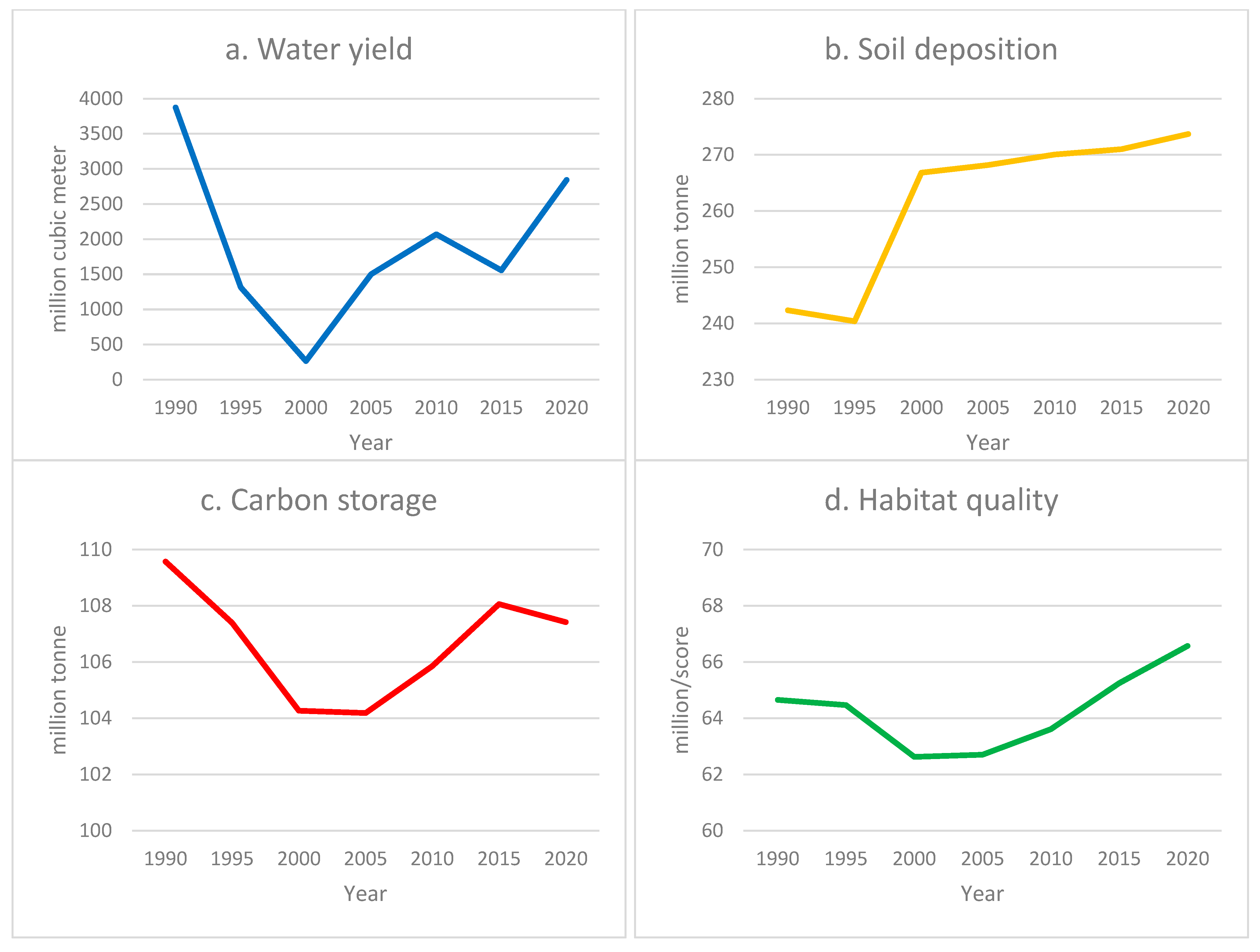
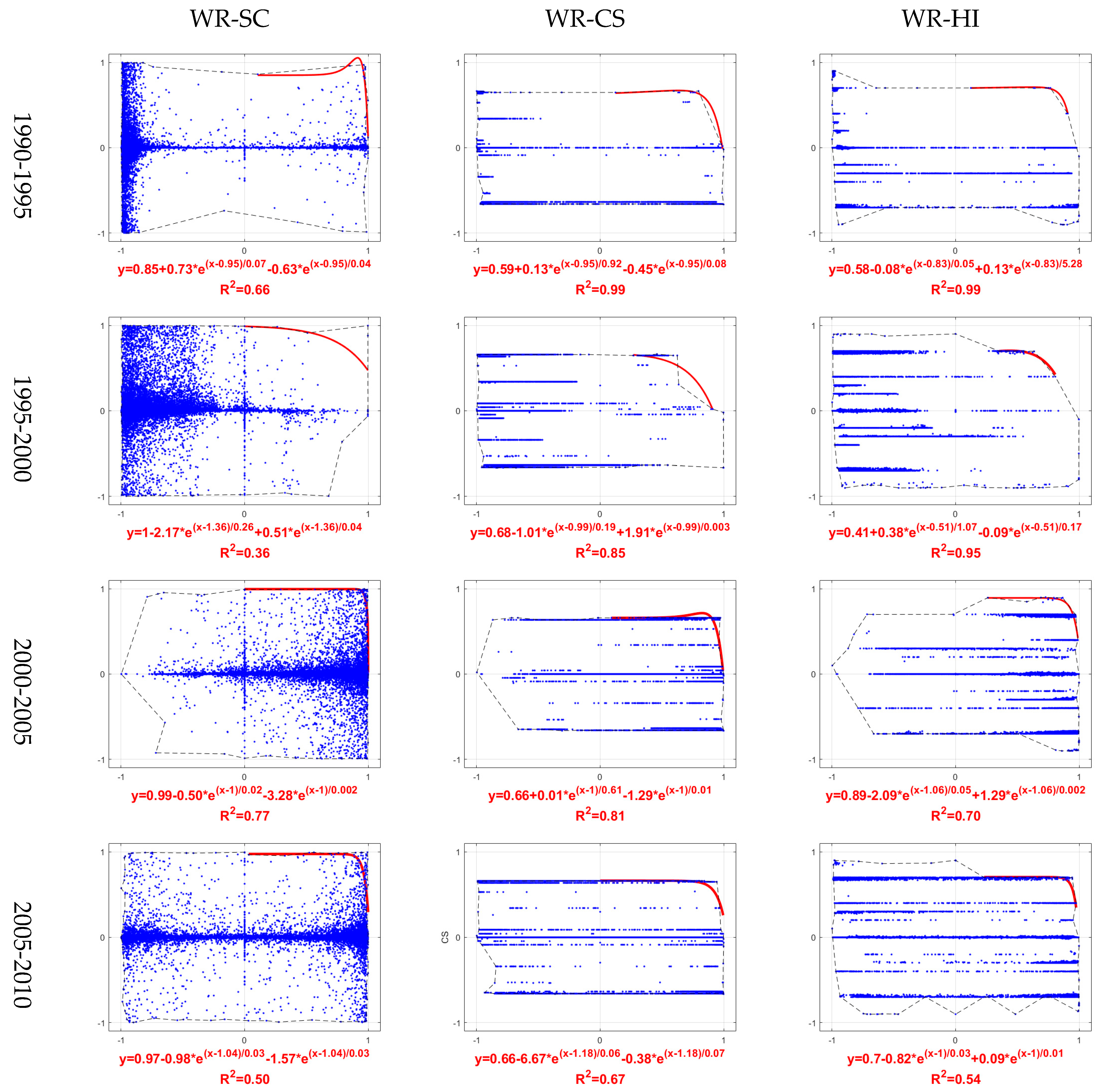
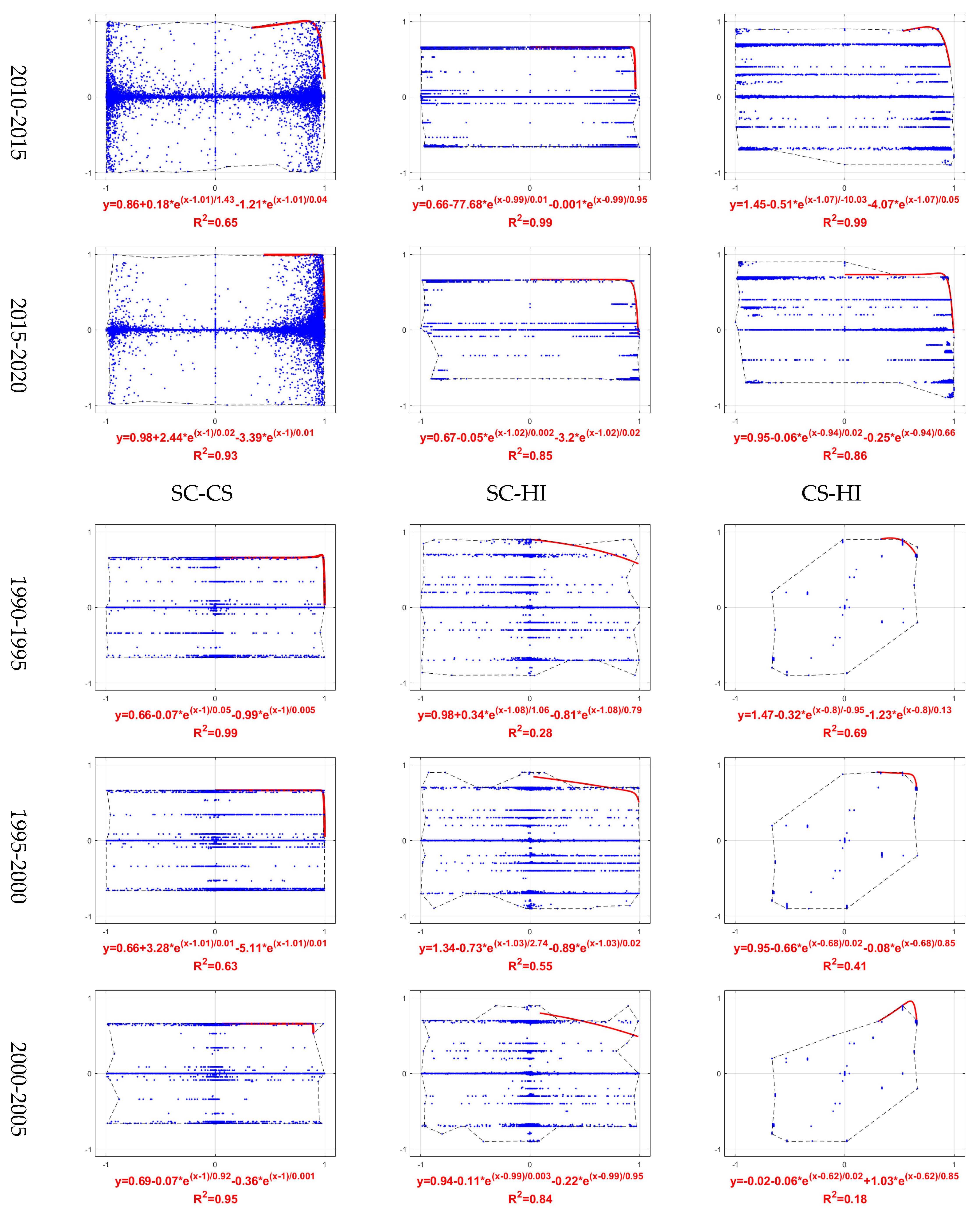
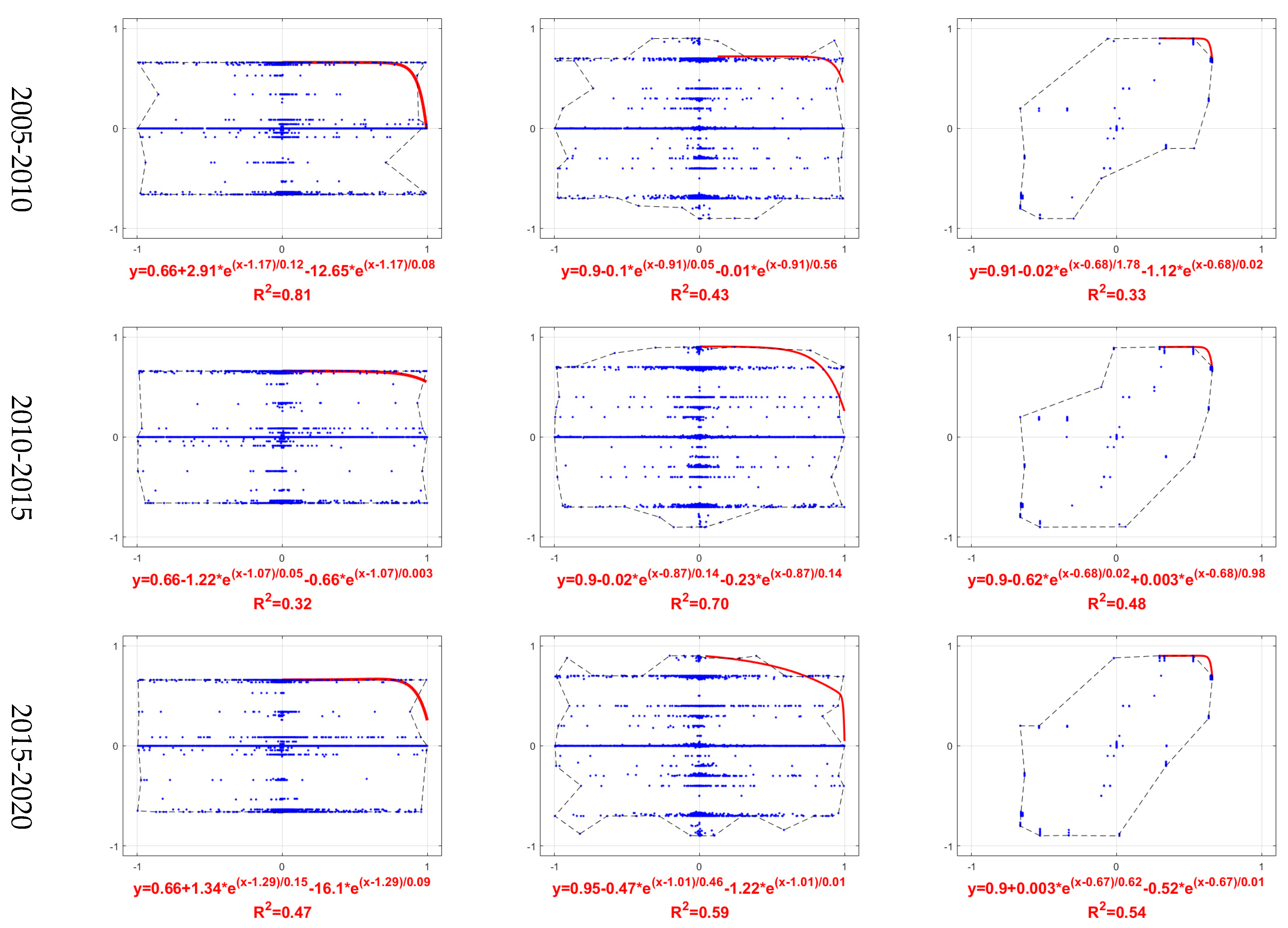
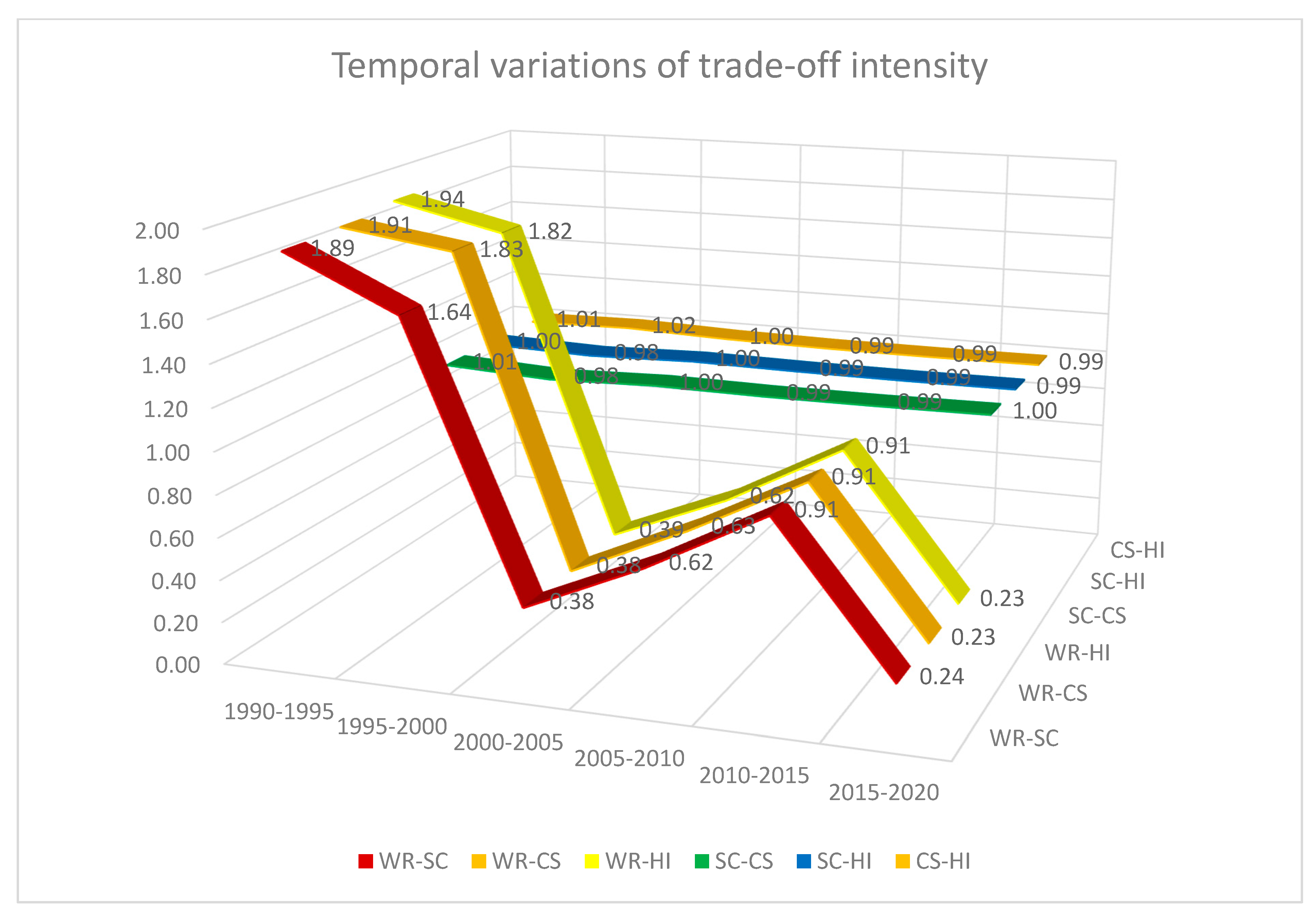
| Data | Type | Resolution | Source | Reference |
|---|---|---|---|---|
| Digital Elevation Model | Raster | 30 m × 30 m | https://asterweb.jpl.nasa.gov/GDEM.asp (accessed on 27 January 2023) | [36] |
| Land Use/Land Cover | Raster | 30 m × 30 m | https://data.casearth.cn (accessed on 27 January 2023) | [37] |
| Rainfall Erosivity | Raster | 1 km × 1 km | http://clicia.bnu.edu.cn/data (accessed on 27 January 2023) | [38] |
| Soil Erodibility | Raster | 250 m × 250 m | http://data.tpdc.ac.cn (accessed on 27 January 2023) | [39] |
| Precipitation | Raster | 1 km × 1 km | http://data.tpdc.ac.cn (accessed on 27 January 2023) | [40] |
| Evapotranspiration | Raster | 1 km × 1 km | http://data.tpdc.ac.cn (accessed on 27 January 2023) | [41] |
| Soil Depth | Raster | 250 m × 250 m | https://data.isric.org (accessed on 27 January 2023) | [42] |
| Volumetric Water Content | Raster | 250 m × 250 m | https://data.isric.org (accessed on 27 January 2023) | [43] |
| Railroad | Vector | 1:250000 | https://www.webmap.cn (accessed on 27 January 2023) | [44] |
| Road | Vector | 1:250000 | https://www.webmap.cn (accessed on 27 January 2023) | [45] |
| ES | Model | Algorithm | Description |
|---|---|---|---|
| Water yield | Annual Water Yield | Pi refers to the annual precipitation (mm/yr) on pixel i, AETi refers to the annual actual evapotranspiration (mm/yr) on pixel i, and AETi/Pi refers to the approximation of the Budyko curve. | |
| Soil deposition | Sediment Delivery Ratio | Ai refers to the amount of annual soil loss (ton/ha/yr) on pixel i, given by the revised universal soil loss equation, where Ri is the rainfall erosivity factor (MJ•mm/ha/hr/yr), Ki is the soil erodibility factor (ton•ha•hr/MJ/ha/mm), LSi (unitless) is the slope length-gradient factor, Ci (unitless) is the cover management factor; and SPi (unitless) is the support practice factor. SDRi refers to the sediment deliver ratio for pixel i derived from the conductivity index, where SDRmax is the maximum theoretical SDR; IC0 and k define the shape of the SDR-IC relationship. | |
| Carbon storage | Carbon Storage and Sequestration | Ca is aboveground biomass (ton/ha), Cb is belowground biomass (ton/ha), Cs is soil carbon storage (ton/ha), Cd is dead organic matter (ton/ha). | |
| Habitat quality | Habitat Quality | Hj refers to the habitat suitability of land use type j, Dij is the total threat level for land use type j on pixel i, and m is half of the maximum value of Dij. |
| Change | Positive | Negative |
|---|---|---|
| Water yield (m3) | Water retention | Water loss |
| Soil deposition (tons) | Soil conservation | Soil loss |
| Carbon storage (tons) | Carbon sequestration | Carbon emission |
| Habitat quality (score) | Habitat improvement | Habitat degradation |
| ES change | 1990–1995 | 1995–2000 | 2000–2005 | 2005–2010 | 2010–2015 | 2015–2020 |
|---|---|---|---|---|---|---|
| WR (million m3) | −2559.42 | −1049.11 | 1234.51 | 568.58 | −512.02 | 1287.38 |
| SC (million tons) | −1.94 | 26.42 | 1.37 | 1.86 | 0.97 | 2.70 |
| CS (million tons) | −2.18 | −3.12 | −0.08 | 1.66 | 2.21 | −0.64 |
| HI (million/score) | −0.18 | −1.84 | 0.07 | 0.91 | 1.64 | 1.33 |
Disclaimer/Publisher’s Note: The statements, opinions and data contained in all publications are solely those of the individual author(s) and contributor(s) and not of MDPI and/or the editor(s). MDPI and/or the editor(s) disclaim responsibility for any injury to people or property resulting from any ideas, methods, instructions or products referred to in the content. |
© 2023 by the authors. Licensee MDPI, Basel, Switzerland. This article is an open access article distributed under the terms and conditions of the Creative Commons Attribution (CC BY) license (https://creativecommons.org/licenses/by/4.0/).
Share and Cite
Jiang, W.; Gao, G.; Wu, X.; Lv, Y. Assessing Temporal Trade-Offs of Ecosystem Services by Production Possibility Frontiers. Remote Sens. 2023, 15, 749. https://doi.org/10.3390/rs15030749
Jiang W, Gao G, Wu X, Lv Y. Assessing Temporal Trade-Offs of Ecosystem Services by Production Possibility Frontiers. Remote Sensing. 2023; 15(3):749. https://doi.org/10.3390/rs15030749
Chicago/Turabian StyleJiang, Wei, Guangyao Gao, Xing Wu, and Yihe Lv. 2023. "Assessing Temporal Trade-Offs of Ecosystem Services by Production Possibility Frontiers" Remote Sensing 15, no. 3: 749. https://doi.org/10.3390/rs15030749
APA StyleJiang, W., Gao, G., Wu, X., & Lv, Y. (2023). Assessing Temporal Trade-Offs of Ecosystem Services by Production Possibility Frontiers. Remote Sensing, 15(3), 749. https://doi.org/10.3390/rs15030749








